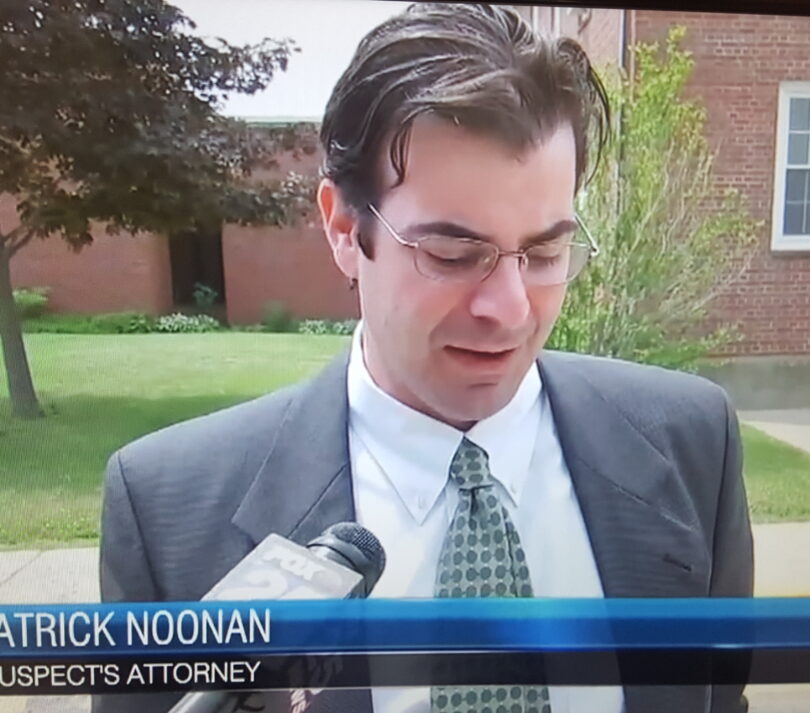WITNESS INTIMIDATION: NOT GUILTY
THREATS: NOT GUILTY
ASSAULT & BATTERY with DANGEROUS WEAPON: NOT GUILTY
ASSAULT & BATTERY with DANGEROUS WEAPON: NOT GUILTY
ASSAULT & BATTERY with DANGEROUS WEAPON: GUILTY
Defendant, and five other Defendants, were employees at a juvenile detention center, which housed juveniles who had been adjudicated delinquent (or found guilty) for crimes and sentenced to serve sentences. The juveniles claimed that the Defendants would regularly threaten them, sexually abuse them, and physically abuse them. The juveniles claimed that the Defendants engaged in a ritualistic form of abuse known as “orange chicken” to punish or discipline them. The orange chicken assault involved the juvenile’s underwear being pulled down and getting smacked on the bare buttocks with an orange rubber sandal. If a juvenile complied with the orange chicken, the punishment would be less severe but if they resisted the assault would more severe. Defendants instructed other juveniles to participate in administering orange chicken assaults to other juveniles. The abuse was not limited to orange chicken assaults, as the juveniles described other forms of physical and sexual abuse by the Defendants. The Department of Children and Families and the Massachusetts State Police conducted an extensive investigation, which resulted in the juvenile facility being completely shut down. The District Attorney’s Office conducted an extensive grand jury investigation, which involved the testimony of juveniles, employees, law enforcement, and resulted in the production of thousands of pages of records and documents.
Result:
Defendant was charged with Witness Intimidation (G.L. c. 268, §13B) to Victim #1 based on Victim #1’s testimony that the Defendants engaged in conduct designed to prevent the juveniles from reporting the abuse. Specifically, the Defendants threatened to put a “green light” on a juvenile if they reported the abuse. A “green light” meant that if a juvenile reported abuse they would be attacked at any other juvenile facility they went to because the Defendants had connections with other facilities. At the close of the Commonwealth’s case, Attorney Patrick J. Noonan had a Not Guilty finding entered on the Witness Intimidation charge because the Commonwealth failed to present sufficient evidence against his client.
Defendant was charged with Threats (G.L. c. 275, §2) to Victim #1 based on Victim #1’s testimony that Defendants threatened to give Victim #1 an orange chicken assault, if Victim #1 did not participate in orange chicken assaults on other juveniles. At trial, Attorney Noonan impeached Victim #1 with prior statements he made where he told police he didn’t recall being told that if he did not participate in orange chicken, he would be next. The most important piece of evidence that won an acquittal on the Threats charge was Attorney Noonan’s cross-examination of Victim #1 where he got Victim #1 to admit that his client never made any such threat to him.
Defendant was charged with Assault and Battery with a Dangerous Weapon (G.L. c. 265, §15A) on Victim #2 based on Victim #2’s testimony that the Defendant assaulted him in the laundry room, forcibly pulled down his pants, and beat him on the bare buttocks with a sandal. Attorney Noonan presented evidence that Victim #2 had falsely accused another staff member of assaulting him in the laundry room during this same incident.
Specifically, Victim #1 testified at the grand jury that this other staff member assaulted him in the laundry and Victim #1 even sued this other staff member for assaulting him in the laundry room. However, when questioned about the incident in the laundry room, Victim #2 admitted that the other staff was not involved. Moreover, Attorney Noonan questioned the facility’s program director at trial who stated that she viewed surveillance video from the laundry room area on the date of the incident and there was no video to corroborate Victim #2’s allegations that the Defendant assaulted him in the laundry room. The police even viewed the video, which did not show any evidence that the Defendant assaulted him in the laundry room. Lastly, Victim #2 claimed that after the assault in the laundry room, he was discharged from the facility. Attorney Noonan presented evidence that Victim #2 met with his case worker shortly after the alleged assault in the laundry room and he did not say anything to his case worker about it.
Defendant was charged with Assault and Battery with a Dangerous Weapon on Victim #3 based on the testimony of a former employee who testified that he witnessed the Defendant beat Victim #3 with a sandal in the cafeteria. The Commonwealth gave this former employee immunity to testify against all defendants. This former employee testified that he personally participated in the assault on Victim #3 in the cafeteria and he witnessed the Defendant participating in the assault. However, during Victim #3’s trial testimony, he testified that the Defendant was present for the incident in the cafeteria but he could not recall if the Defendant participated. During his closing argument, Attorney Noonan cited the law, which states that “no defendant…shall be convicted solely on the basis of the testimony of…a person granted immunity.” G.L. c. 233, §20I. Attorney Noonan argued that the only evidence of the Defendant involvement in the assault and battery on Victim #3 came from the testimony of an immunized witness. Attorney Noonan argued and the Commonwealth failed to prove the Defendant’s guilt beyond a reasonable doubt, as the Commonwealth did not present any other evidence to corroborate the testimony of its immunized witness.
Defendant was charged with Assault and Battery with a Dangerous Weapon on Victim #3 based on Victim #3’s testimony that the Defendant choked him with a wooden drumstick in the hallway. The jury convicted the Defendant on this one and only charge. However, Attorney Noonan presented evidence that there were cameras that would have captured the incident in the hallway and the program director testified that she did not see any video footage of any assault on Victim #3 in the hallway. Moreover, Victim #3 testified that he assaulted the Defendant for no reason. Attorney Noonan argued that the Defendant was legally entitled to use force to restrain juveniles in the course of his employment and he had a right to act in self-defense. Attorney Noonan cited the testimony of another employee who stated that “restraints” on juveniles’ are difficult to perform alone without any assistance from other employees. This employee testified that it is very difficult to perform a “restraint” in the manner they are trained to do where a juvenile violently attacks an employee and an employee has to do whatever he can to restrain the juvenile. In this case, Defendant was violently attacked by Victim #3 who was known to be violent and had previously attacked other juveniles and staff. The Commonwealth did not present evidence of the entire incident or the full picture of what happened. How can the Commonwealth say that the Defendant’s force to restrain Victim #3 was unreasonable when there were so many unanswered questions about what actually happened? How can it be said that the Defendant’s restraint was excessive when the Commonwealth did not any present evidence with regards to the severity of Victim #3’s assault on the Defendant? Defendant’s response would be appropriate if he was faced with a violent assault by a violent person.
At the end of this lengthy trial, the jury acquitted the Defendant on all charges, except for one.



